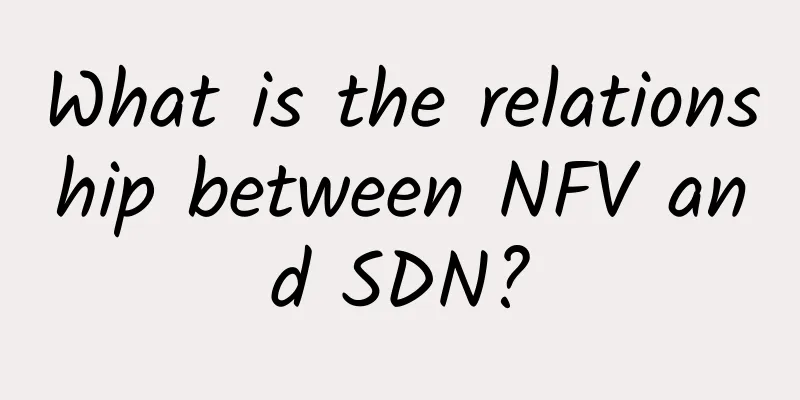What is the relationship between NFV and SDN?

|
NFV and SDN are popular technologies that have emerged in the information and communication industry in recent years and are extremely popular. Especially after the advent of the 5G era, the frequency of their appearance has increased dramatically. As I have a deeper understanding of these two concepts, many readers have asked me this question: NFV and SDN seem to have nothing to do with each other. Why do they often appear together under the name of "NFV/SDN"? Are they really related? What kind of connection is it? Today, Xiaozaojun will talk to you about this topic. First, let’s briefly review what NFV and SDN are. What is NFV NFV, the full name is Network Function Virtualization, network function virtualization. This word can actually be broken down into two parts: network function refers to the function of mobile communication network equipment. And virtualization is a cloud computing technology. To be precise, it is the core key technology of cloud computing. Everyone is talking about cloud computing every day, but what is the essence of cloud computing? The so-called cloud computing is to migrate computing resources from local to cloud to achieve "cloudification". Computing resources mainly refer to servers, which have CPU, memory, hard disk and network card, and can provide various computer services by installing operating system and software. However, if you simply move the server hardware to the cloud computer room, it is not true cloud computing, at best it can only be called hosting. This method lacks sufficient flexibility and efficiency when allocating resources. The hardware configuration of the machine cannot be flexibly changed, the operating system installation is also slow and laborious, and it cannot be changed at will. Therefore, cloud computing introduced virtualization technology. Virtualization technology is to deploy a virtualization software platform on the basis of physical servers to unify the management of computing resources (such as CPU, memory, etc.), storage resources (such as hard disk), network resources (such as network card) and other resources, and allocate them on demand. Under the management of the virtualization platform, several physical servers become a large resource pool. On the resource pool, several virtual servers (virtual machines) can be divided, and operating systems and software services can be installed to realize their respective functions. Our mobile communication network, especially the core network, is composed of many network element devices. These network elements are themselves customized servers. The software services running on the network elements ensure that the functions can be realized. In the past, these network elements were all dedicated equipment designed and manufactured by various manufacturers. Now, as the hardware capabilities of x86 general-purpose servers continue to increase, the communications industry has begun to learn from the IT industry, introducing cloud computing technology, using x86 general-purpose servers to replace manufacturer-specific servers, and "clouding" the core network. The core network architecture design also draws on the IT microservice concept and becomes the SBA architecture (Service Based Architecture). Simply put, it changes "one server to realize multiple functions" to "multiple servers to realize their own functions". N virtual machines, N functions, each operating independently and isolated from each other. By adopting NFV technology and cloudifying the network elements of communication equipment, the complete decoupling of software and hardware can be achieved. Operators no longer need to purchase dedicated hardware equipment manufactured by manufacturers, which greatly reduces hardware capital investment. NFV also has the advantages of automatic deployment, elastic scaling, fault isolation and self-healing, which can greatly improve network operation and maintenance efficiency and reduce risks and energy consumption. Therefore, operators have a strong demand for NFV technology. In addition to the core network, operators are also promoting the implementation of NFV in the access network, that is, allowing base stations to embrace virtualization. What is SDN Let’s take a look at SDN. SDN, Software Defined Networking, can also be understood as software-defined network, software-controlled network, programmable network. The design concept of SDN is actually the same as that of NFV, which is to improve system flexibility through decoupling. NFV is the decoupling of software and hardware, while SDN is the decoupling of the control plane and the forwarding plane. The core function of the bearer network is to transmit data. The transmission process is the process of continuously routing and forwarding data packets. Control and forwarding, the former is a command, and the latter is work. In traditional networks, each forwarding node (such as routers and switches) works independently, and the internal management commands and interfaces are proprietary to the manufacturer and not open to the outside world. The SDN network is to establish an SDN controller node on the network to uniformly manage and control the data forwarding of the lower-level devices. The management function of all lower-level nodes is stripped away (handed over to the SDN controller), leaving only the forwarding function. The network under SDN control becomes simpler. For upper-layer applications, no matter how complex the network is, it is invisible. The administrator only needs to perform simple deployment like configuring a software program to enable the network to implement new routing and forwarding strategies. If it is a traditional network, each network device needs to be configured separately. The working process of SDN is based on Flow. The interface protocol between the SDN controller and the lower-level nodes is OpenFlow. Only devices that support OpenFlow can be managed by the SDN controller. The way SDN controls is to send FlowTable. After adopting SDN, the flexibility and scalability of the entire data network have been greatly increased. At the same time, SDN's characteristics of simplifying network configuration and saving operation and maintenance costs are also popular among operators. In addition to mobile communications, many WAN, MAN, and private line services are embracing SDN. For example, the hotly discussed SD-WAN is the introduction of SDN into WAN to replace expensive private lines. In short, SDN is the main direction of future development of data communication networks. The Relationship between NFV and SDN Okay, now let’s talk about the relationship between NFV and SDN. In my opinion, the relationship between NFV and SDN is not that big. The two technologies not only have different implementation principles, but also different application scenarios. NFV is a typical computing technology, and SDN is a typical network technology. The relationship between the two is like the relationship between a server and a switch. In the ISO seven-layer model, NFV is layers 4-7 and SDN is layers 2-3, which is a huge difference. From the perspective of mobile communications, NFV is mainly used in core networks and access networks, while SDN is mainly used in bearer networks. The two are also different fields. If the two are so different, why are they often mentioned together? In fact, it’s mainly because of 5G. SDN is the decoupling of control and forwarding, and NFV is the decoupling of software and hardware. Both are decoupling, with only one purpose, which is flexibility. And the purpose of flexibility is to serve network slicing. 5G Network Slicing Network slicing is a core capability and key feature of 5G. The SA and NSA networks that were hotly debated before. NSA does not support network slicing. Only SA supports network slicing. SA is the authentic 5G, while NSA can only be regarded as "half 5G" or "5G-". Now all major operators are working hard to develop 5G NFV core network (refer to the announcement of China Mobile's NFV bidding results a few days ago), which also serves 5G SA networking and prepares equipment for network slicing. At the same time, the operators' bearer network transformation is also in full swing. The 5G bearer network solutions promoted by the three major operators all have one core element, which is the comprehensive introduction of SDN. In summary, the network architecture adopts SA networking, the bearer network adopts SDN, and the core network adopts NFV, which is a prerequisite for 5G to become "true 5G". Although NFV and SDN have no affiliation or dependency relationship, they do have complementary and cooperative relationships. For example, after NFV data centers adopt SDN, the performance of NFV networks can be effectively improved. In addition, although SDN is adopted by network devices, these network devices can actually introduce virtualization like servers. In other words, virtualization is not limited to computers. NFV is leading the future of computing, and SDN represents the future of networking. Together, the two will usher in an unprecedented new era of ICT. Well, that’s all for today. I hope it helps you. Thank you! |
<<: Story: Tang Sanzang's journey to the west: the whole process of network communication
>>: In the face of the epidemic, 5G construction should not only be accelerated, but also increased!
Recommend
Don't understand the network I/O model? How to get started with Netty
Netty is a network application framework, so from...
How to ensure the security of 5G wireless networks
5G creates opportunities for both users and cyber...
Ten questions about the issuance of 5G temporary licenses: how far is 5G?
Recently, authoritative information about 5G has ...
HostKvm 20% off: Korea/Hong Kong CN2 data center VPS monthly payment starts from US$7.6
HostKvm was founded in 2013. It currently provide...
IMIDC server restock: Hong Kong & Taiwan starting from $39/month / Japan server starting from $49/month
IMIDC (Rainbow Network) Hong Kong, Taiwan and Jap...
5G market is rapidly expanding and artificial intelligence scenarios are becoming a reality
[[183832]] In response to the explosive growth of...
Cache + HASH = high concurrency? You think the high concurrency architecture is too simple!
[51CTO.com original article] In the Internet era,...
UFOVPS limited 30% off, Japan/Hong Kong CN2 GIA/US high-defense VPS monthly payment starts from 26 yuan, top up 200 yuan and get 20 yuan
UFOVPS has launched a promotional event during th...
5G development still has a long way to go
The construction and development of 5G has gone t...
A Brief Discussion on WebSocket Protocol-RFC 6455
Labs Guide Before the emergence of WebSocket, the...
What are honeypots, honey baits, honey tags, honeynets, honey farms... in network security?
As security practitioners, whether we are doing p...
Gcore (gcorelabs) Ashburn (Virginia) VPS simple test
Previously, I conducted a simple test on some of ...
The AI dual competitions will enter the final round in August. Huawei invites you to witness the birth of the champions of the DIGIX Geek Artificial Intelligence Campus Innovation Competition and the Algorithm Elite Competition!
[51CTO.com original article] This summer, two eve...
Under the Dome: Green Thoughts on Data Centers
The night of *** in February 2015 was destined to...
Edge chips could render some networks useless
【51CTO.com Quick Translation】Some scientists say ...









